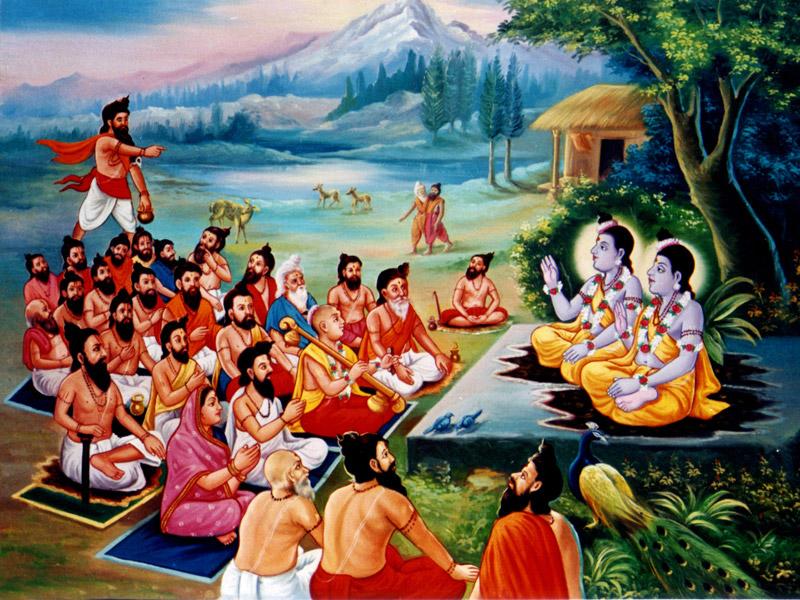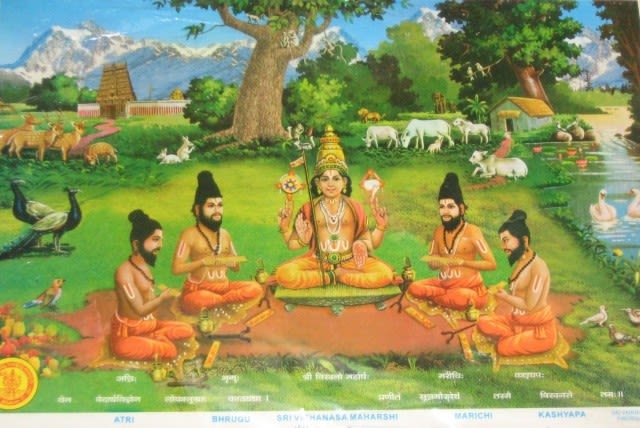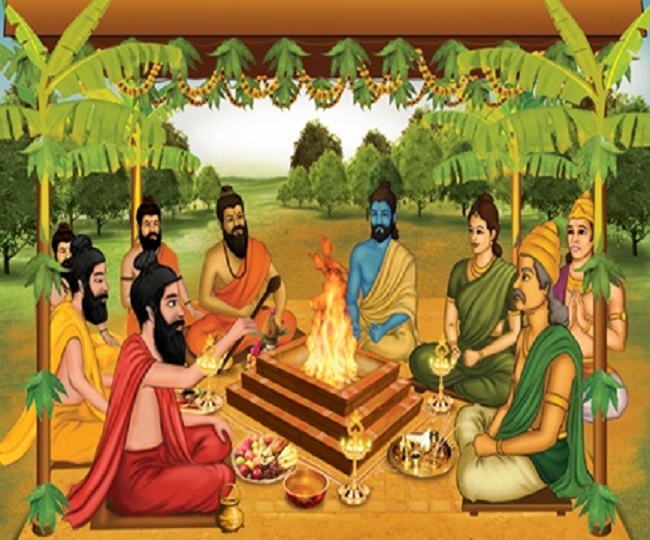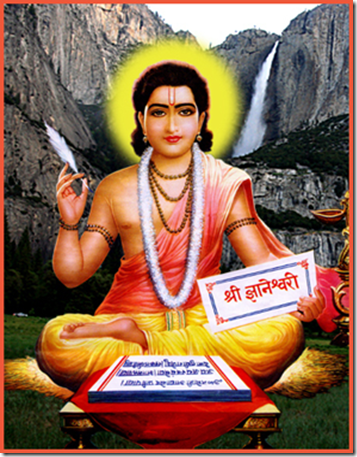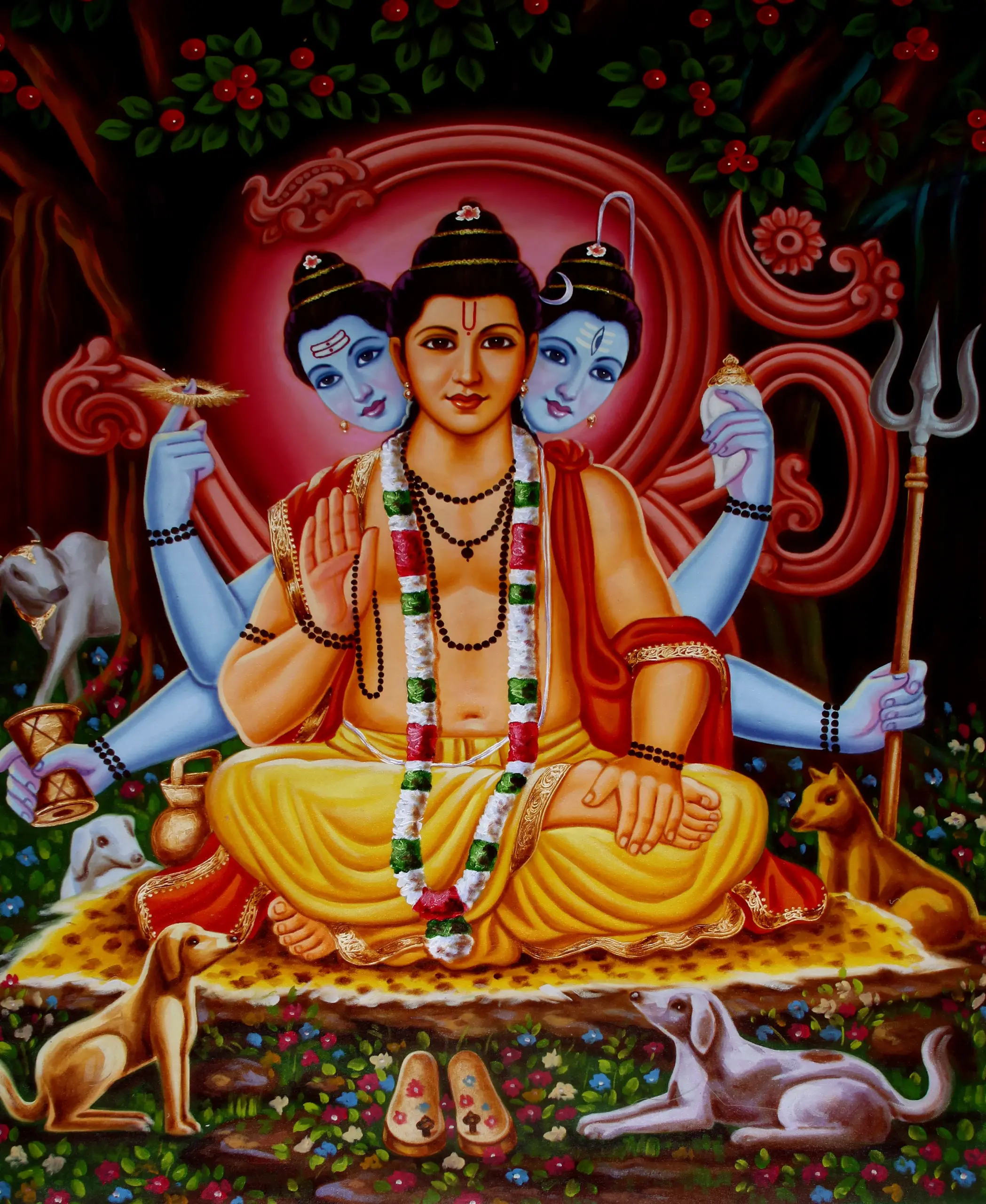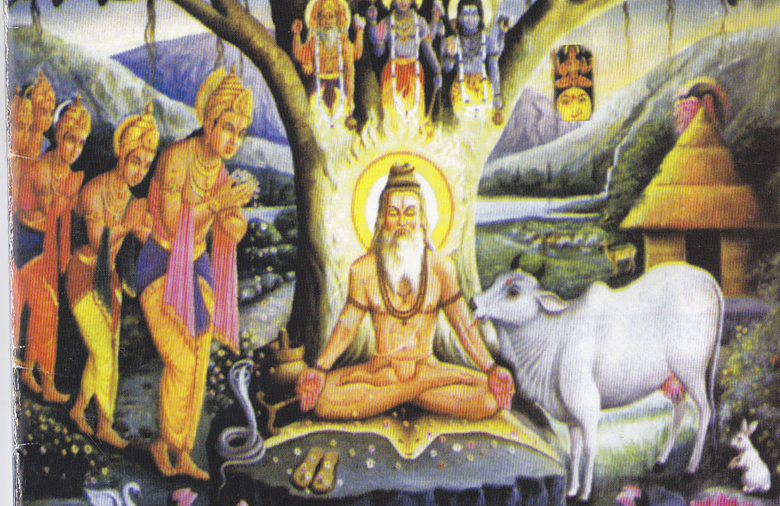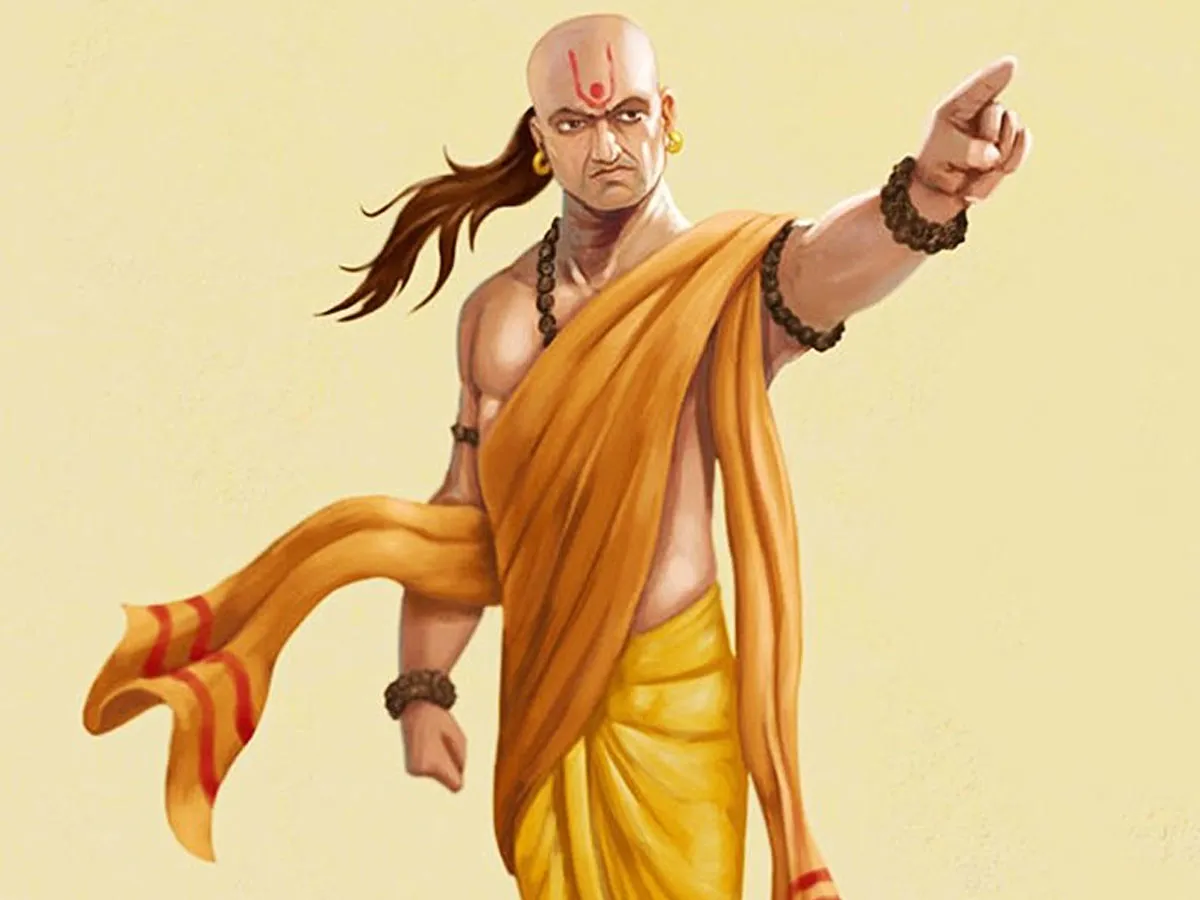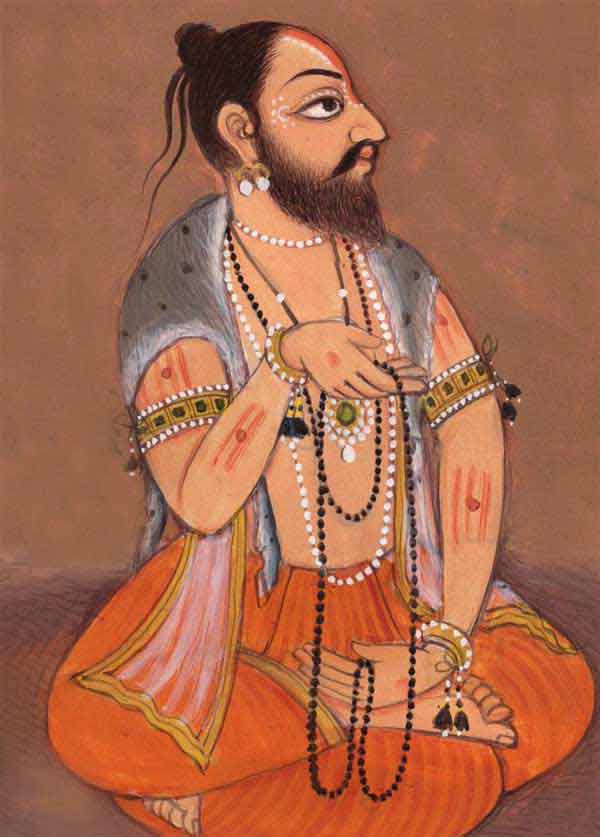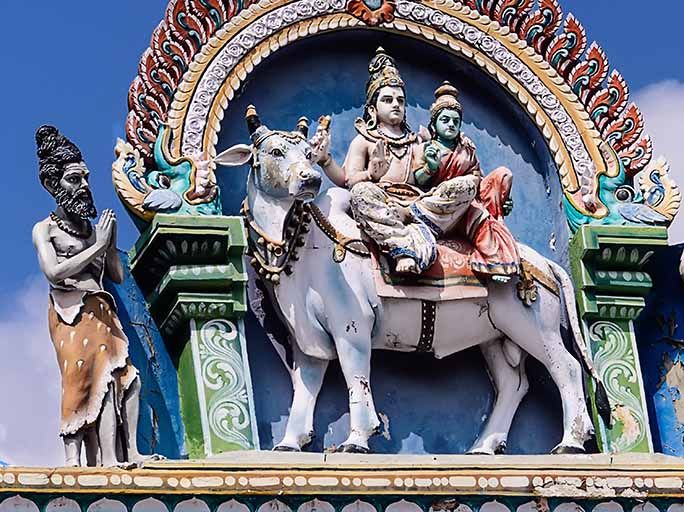Druvasa, also spelled Durvasa or Durvasas, is a well-known and sometimes notorious sage in Hindu mythology. He is considered one of the incarnations of Lord Shiva’s anger. Druvasa is renowned for his extreme temper and the curses he is said to have bestowed upon various individuals. Here are key points associated with Druvasa:
- Parentage: Druvasa is often described as the son of Atri, one of the Saptarishi (seven great sages). Atri is known for his deep penance and devotion.
- Curse on Shakuntala: In the Mahabharata, there is a famous incident involving Druvasa and the character Shakuntala. Shakuntala, the daughter of the sage Vishwamitra and the apsara Menaka, was cursed by Druvasa due to an unintentional slight. As a result of the curse, King Dushyanta, Shakuntala’s husband, forgot her until he saw the ring he had given her.
- Ambarisha’s Story: Another well-known story involves King Ambarisha, a devoted worshiper of Lord Vishnu. Druvasa felt challenged when Ambarisha’s devotion surpassed his own. In a fit of rage, Druvasa created a demon to harm Ambarisha. However, the Sudarshana Chakra, the divine discus of Vishnu, protected Ambarisha. In response, Lord Vishnu became angry with Druvasa for attacking his devotee. Druvasa had to seek forgiveness from Ambarisha.
- Druvasa and Draupadi: Perhaps one of the most famous incidents involving Druvasa is found in the Mahabharata. Once, during the Pandavas’ exile, Druvasa visited them with several disciples. Draupadi had nothing to offer them, as the Pandavas were in a state of penury. In a moment of desperation, Draupadi prayed to Lord Krishna, who miraculously provided food. Druvasa and his disciples were satisfied, preventing a potential disaster.
- Boons and Curses: Druvasa is said to have received many boons from various deities due to his austerities. However, his quick temper often led to curses being pronounced, sometimes even against those who sought his blessings.
- Final Pilgrimage: In some accounts, it is mentioned that Druvasa undertook a pilgrimage to various holy places and ultimately attained liberation.
Druvasa’s character serves as a reminder of the power of austerities and the need for self-control. His stories highlight the importance of humility and devotion, as well as the consequences of unbridled anger. Despite his short temper, Druvasa is also revered as a great sage and a master of mystical knowledge.
In Hindu mythology, Durvasa (दुर्वास in Devanagari or durvāsa in IAST, pronounced [d̪urʋɑːsɐ] in classical Sanskrit), or Durvasas, was an ancient sage, the son of Atri and Anasuya. He is supposed to be an incarnation of Shiva.[1][2][3][4][5] He is known for his short temper. Maledictions or curses he gave in his rage ruined many lives. Hence, wherever he went, he was received with great reverence (out of fear) from humans and Devas alike. He is commonly portrayed as desiring to enjoy others’ hospitality, and becoming exceedingly angry when hosts display any sort of impropriety or fail to please him as a guest. Conversely, hosts who serve him well are often blessed by him.
Durvasa is also known as one who wore torn/tattered clothes and purposely belittled himself to bring out the greatness of the devotees of the Lord. That is why he is also known as Bhagavan Durvasa.
Birth
According to Chapter 44 of the Brahmananda Purana, Brahma and Shiva once got into a heated quarrel. So violent was Shiva’s rage as a result of this quarrel, that the Devas fled from his presence in fear. His consort, Parvati, complained that Shiva was now impossible to live with. Realising the disharmony his anger had caused, he decided to deposit this anger into Anasuya, the wife of sage Atri. From this portion of Shiva deposited into Anasuya, a child was born, who was named Durvasa (literally, one who is difficult to live with). Because he was born of Shiva’s anger, he had an irascible nature.
The Bhagavata Purana gives a somewhat different account of Durvasa’s birth. In this version, Atri performed severe penance to propitiate the Supreme Being in order to obtain a son by Anasuya who would be just like Him. Pleased with him, Brahma, Vishnu, and Shiva (being but different manifestations of the Supreme) blessed the sage that portions of themselves would be born as his sons. In due course, Anasuya bore Soma (Brahma’s incarnation), Dattatreya (Vishnu’s), and Durvasa (Shiva’s).
Role in the Churning of the Ocean
In the Vishnu, Vayu, and Padma Puranas, a curse that Durvasa laid upon Indra is described as the indirect reason for the famous churning of the ocean. The Bhagavata and Agni Puranas also mention Durvasa’s involvement in the episode in passing, without going into the details. Other sources for this story, such as the Ramayana, Mahabharata, Harivamsa, and Matsya Purana, do not mention Durvasa’s involvement at all, and ascribe the incident to other causes, such as the Devas’ and Asuras’ desire for immortality.
The story in the Vishnu Purana goes that Durvasa, while wandering the earth in a state of ecstasy due to a vow of insanity he was observing, came by a Vidyadhari (a nymph of the air) and demanded of her a heavenly wreath of flowers she was wearing. The nymph respectfully gave the garland to the sage, whereupon he wore it on his brow. Resuming his wanderings, the sage came across Indra riding his elephant, Airavata, attended by the gods. Durvasa, still in his state of frenzy, threw the garland at Indra, who caught it and placed it on Airavata’s head. The elephant was irritated by the fragrance of the nectar in the flowers, so it threw the garland to the ground with its trunk. Durvasa was enraged to see his gift treated so callously and cursed Indra that he would be cast down from his position of dominion over the three worlds, just as the garland was cast down. Indra immediately begged Durvasa’s forgiveness, but the sage refused to retract or even soften his curse, and went on his way. Because of the curse, Indra and the Devas were diminished in strength and shorn of their lustre. Seizing this opportunity, the Asuras led by Bali waged war against the gods. The gods were routed and turned to Brahma for help. Brahma directed them to seek refuge with Vishnu. Vishnu in turn, advised them to call a truce with the Asuras and work together with them to churn the Milky Ocean and obtain the Nectar of Immortality, on the pretext of sharing it with them. Vishnu promised that he would ensure only the Devas drank the Nectar and obtained immortality so they could once again defeat the Asuras. The Devas took Vishnu’s advice and called their truce with the Asuras, and thus did the gods and demons begin planning their great enterprise.
Meeting with Ambarisha
Sage Durvasa’s confrontation with Ambarisha is a famous story from the Bhagavata Purana. Ambarisha was a great devotee of Vishnu and adhered firmly to the truth. He performed a Yagnya with such great devotional fervour that Narayana was pleased to bless him with his Sudarshana Chakra (“Sudarshana” meaning “good-looking” or “beautiful”), as a shield of protection over him. Once, Ambarisha performed a religious rite known as the Ekadashi and Dvadashi Vrata, for 1 year (i.e. the king would fast on the 11th day of every lunar month, and break his fast the next day). After observing this practice for a year, he took up a final fast of 3 days and nights to conclude the rite. As the moment for breaking this fast drew near, sage Durvasa arrived where Ambarisha was and the king received him with due respect. Durvasa agreed to the king’s request to be his honoured guest, and asked the king to wait until he had finished his bath in the river Yamuna. The auspicious moment soon arrived when the king had to break his fast to fulfill his vow, but Durvasa had not yet returned from his bath. Ambarisha was in a dilemma, as, on the one hand, it was impolite to take food before serving a guest, but on the other, the time had come for the fast to be broken. After consulting his priests, the king broke his fast by taking a sip of water, and awaited Durvasa’s arrival to offer him food.
Durvasa felt that Ambarisha had violated the respect due to a guest by breaking his fast before the guest had taken his meal, and in his rage created a demon to kill Ambarisha, out of a strand of his hair. Narayana’s Sudarshana Chakra intervened, destroyed the demon and started chasing Durvasa himself. Durvasa went to Brahma and Shiva for protection. Both pleaded their inability to save him. Durvasa next went to Narayana himself, who said that he could do nothing as he was bound by the blemishless devotion of Ambarisha and suggested that the sage seek the king’s pardon. Durvasa took this adivce and returned to Ambarisha, who prayed to Vishnu to recall the Sudarshana and save the sage, whereby the discuss ceased to afflict him.
However, a different story is given in the Shiva Purana.[citation needed] Ambarisha ended his vrata before serving Durvasa his meal and thus insulted sage, who was angered and decided to kill him. To protect Ambarisha, the Sudarshana came, but on seeing that Durvasa was Shiva himself (portrayed in the Shiva Purana as the Supreme Being), it stopped. Then Nandi told Ambarisha that he should beg Durvasa for forgiveness as he was none other than Shiva, there to test the king. Recognising this, Ambarisha took Nandi’s advice and prayed to Durvasa, who, being gratified, blessed the king.
Durvasa and Shakuntala
In the Abhijñānashākuntala, written by Kalidasa, when the maiden Shakuntala ignored Durvasa’s demands to be welcomed as a guest because she was daydreaming about her lover, Dushyanta, he cursed her that her lover would forget her. Horrified, Shakuntala’s companions managed to mollify Durvasa, who softened the curse, saying that Dushyanta would remember Shakuntala when he saw the ring that he gave her as a token of their love. The sage’s curse came true of course, and was eventually lifted, just as he said it would be. By the end of the play, the two lovers are reconciled, and are happy to be together again, along with their son, Bharata.
Durvasa, Rama, and Lakshmana
In the Uttara Kanda of Valmiki’s Ramayana, Durvasa appears at Rama’s doorstep, and seeing Lakshmana guarding the door, demands an audience with Rama. At the time, Rama was having a private conversation with Death disguised as an ascetic. Before the conversation began, Death gave Rama strict instructions that their dialogue was to remain confidential, and anyone who entered the room and saw or heard them was to be executed. Rama agreed and entrusted Lakshmana with the duty of guarding his door and fulfilling his promise to Death. Thus, when Durvasa made his demand, Lakshmana politely asked the sage to wait until Rama had finished his meeting. The sage grew angry and threatened to curse all of Ayodhya if Lakshmana did not immediately inform Rama of his arrival. Lakshmana, in a dilemma, decided it would be better that he alone die to save all of Ayodhya from falling under Durvasa’s curse, and so interrupted Rama’s meeting to inform him of the sage’s arrival. Rama quickly concluded his meeting with Death and received the sage with due courtesy. Durvasa told Rama of his desire to be fed, and Rama fulfilled his guest’s request, whereupon the satisfied sage went on his way. Rama was overcome with sorrow, for he did not want to kill his beloved brother, Lakshmana. Still, he had given his word to Death and could not go back on it. He called his advisers to help him resolve this quandary. On Vasishta’s advice, he ordered Lakshmana to leave him for good, since such abandonment was equivalent to death as far as the pious were concerned. Lakshmana then went to the banks of the Sarayu, resolved on giving up the ghost via Yoga. Unseen by anyone, Indra took him to heaven.
Durvasa and Kunti
In the Mahābhārata, Durvasa is known for granting boons to those who had pleased him, particularly when he had been served well as an honoured guest. An example of such behaviour is the episode between him and Kunti (the future wife of Pandu and mother of the Pandavas). When Kunti was a young girl, she lived in the house of her adopted father, Kuntibhoja. Durvasa visited Kuntibhoja one day, and sought his hospitality. The king entrusted the sage to his daughter’s care and tasked Kunti with the responsibility of entertaining the sage and meeting all his needs during his stay with them. Kunti patiently put up with Durvasa’s temper and his unreasonable requests (such as demanding food at odd ours of the night) and served the sage with great dedication. Eventually, the sage was gratified. Before departing, he rewarded Kunti by teaching her Atharva Veda Mantras which enabled her to invoke any god of her choice to beget children by them. It was by the use of this mantra that she was able to call the following gods:
- Surya – He blessed her with a son named Karna, the unknown eldest Pandava
- Dharma or Yama – He blessed her with a son named Yudhisthira, most righteous of the Pandavas.
- Vayu – He blessed her with a son named Bhima, of great strength
- Indra – He blessed her with a son named Arjuna, the great archer
- The twin Ashvins – They blessed Madri (Pandu’s second wife) with beautiful twins named Nakula and Sahadeva.
Protecting Draupadi’s Modesty
Contrary to the more famous Mahābhārata version of Dushasana’s attempted disrobing of Draupadi, the Shiva Purana (III.19.63-66) attributes her miraculous rescue to a boon granted by Durvasa. The story goes that the sage’s loincloth was once carried away by the Ganga’s currents. Draupadi quickly tore a piece of her garment to cover him. The sage was pleased with her. He granted Draupadi a boon which caused an unending stream of cloth to cover her when Dushasana was trying to strip her in Hastinapura’s royal dice-hall.
Durvasa and Duryodhana
Another example of Durvasa’s benevolent side is the incident when he granted Duryodhana a boon. During the Pandavas’ exile, Durvasa and several disciples arrived at Hastinapura, and were gratified by Duryodhana’s devoted hospitality. Durvasa was pleased enough to grant him a boon. Duryodhana, secretly wanting Durvasa to curse the Pandavas in anger, asked the sage to visit his cousins in the forest after Draupadi had eaten her meal, knowing that the Pandavas would then have nothing to feed him.
Visiting the Pandavas
So Durvasa and his disciples visited the Pandavas in their hermitage in the forest, as per Duryodhana’s request. During this period of exile, the Pandavas would obtain their food by means of the Akshaya Patra, which would become exhausted each day once Draupadi finished her meal. Because Draupadi had already eaten by the time Durvasa arrived that day, there was no food left to serve him, and the Pandavas were very anxious as to their fate should they fail to feed such a venerable sage. While Durvasa and his disciples were away bathing at the river, Draupadi prayed to Krishna for help. Krishna immediately appeared before Draupadi saying he was extremely hungry, and asked her for food. Draupadi grew exasperated and said she had prayed to Krishna precisely because she had no food left to give. Krishna then told her to bring the Akshaya Patra to him. When she did, he partook of the lone grain of rice and piece of vegetable that he found stuck to the vessel and announced that he was satisfied by the “meal”. This satiated the hunger of Durvasa and his disciples, as the satisfaction of Krishna (portrayed here as the Supreme Being who pervades the entire Universe) meant the satiation of the hunger of all living things. The sage Durvasa and his disciples then quietly left after their bath, without returning to the Pandavas’ hermitage, for they were afraid of facing what they thought would be the Pandavas’ wrathful reaction at their impolite behaviour of refusing the food that would be served to them.
Durvasa and Swaminarayan
According to the followers of Swaminarayan Hinduism, Narayana took birth as the saint Swaminarayan due to a curse by Durvasa. The story goes that shortly after Krishna’s passing, Uddhava proceeded to Badarikashram, the abode of Nara-Narayana. He joined the many divine sages and saints who were there listening to Narayana’s discourses. As Narayana was speaking, Durvasa arrived at the assembly from Mount Kailash, but no one noticed him because they were all so engrossed in the discourse. He waited one Ghadi for someone to welcome him with the respect he felt he was entitled to, but still no one realised he was there. Seeing no one rise to receive him, he took this as an insult and cursed the entire assembly, saying that they would all be born as humans and suffer insults and agony from the wicked. Nara-Narayana’s parents, the god Dharma and goddess Bhakti, pacified Durvasa, who then softened his curse saying that Narayana Himself (again, represented here as the Supreme Being) would be born as Dharma and Bhakti’s son, and His birth would relieve them all from the clutches of evil. So saying, Durvasa made his way back to Kailash.
Dharma and Bhakti were eventually born as Hariprasad Pande (a.k.a Dharmadev) and Premvati Pande (a.k.a. Bhaktidevi). Sure enough, Narayana was born as their son, named Ghanshyam, who is now known as Swaminarayan.

